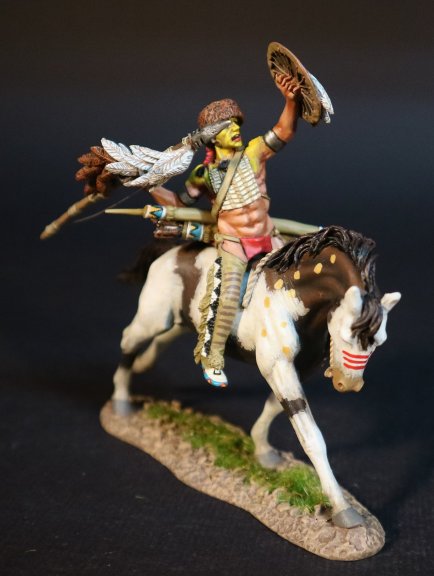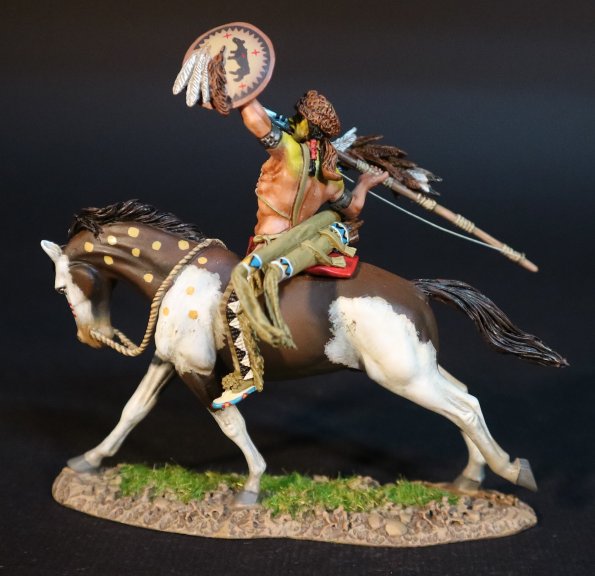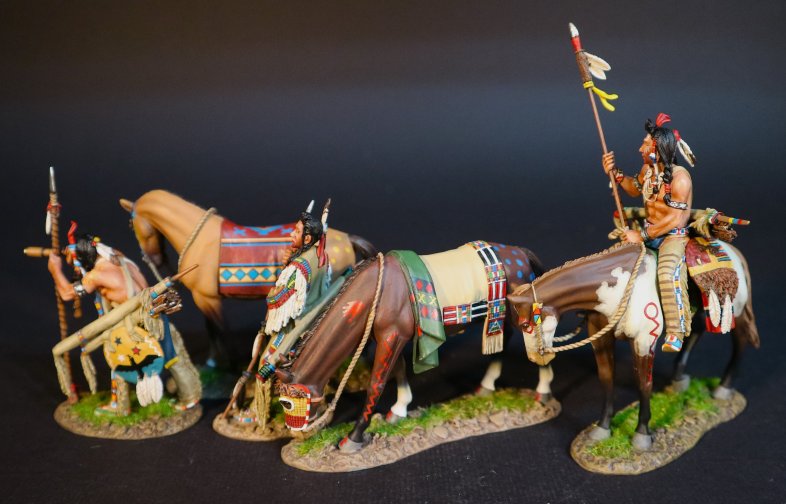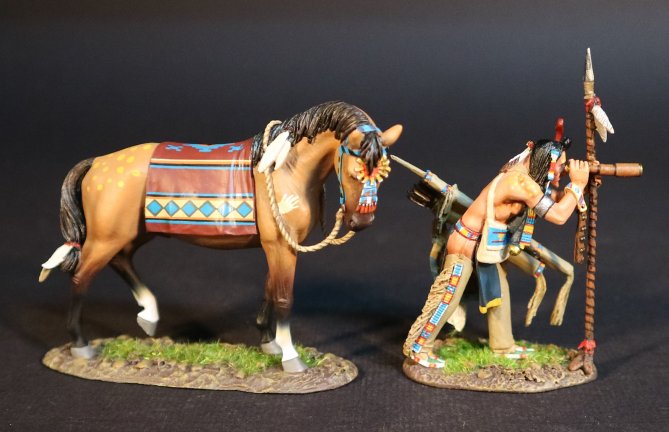- Joined
- Feb 2, 2011
- Messages
- 2,093
NEW RELEASES FOR NOVEMBER 2023
THUNDER ON THE PLAINS
THE BLACK HILL WARS 1876-1877
THE BATTLE WHERE THE GIRL SAVED HER BROTHER, 17[SUP]th[/SUP] JUNE 1876
The Cheyenne named, the more commonly known The Battle Of The Rosebud, The Battle Where The Girl Saved Her Brother. This was because of an incident during the fight involving the Cheyenne woman Buffalo Calf Road Woman, and her brother Chief Comes In Sight.
The battle took place on June 17[SUP]th[/SUP] 1876 in the Montana territory , between the United States Army and its Crow and Shoshoni allies, against a force consisting mostly of Sioux and Cheyenne Indians.
Led by Crazy Horse, the Sioux and Cheyenne managed to halt the offensive of General George Crook, untill August.

Warrior Societies were an important aspect of the Plains life, which divided a tribe’s fighting men into distinct units which provided their members with a social club, and an organization in which they could progress through ranks of officership to bring great prestige.
Among the Lakota there existed several Warrior societies. The main function of these societies was for the training and development of fighting skills and the warrior ethos.
Moral character was also cultivated and taught.

SSB-14
THUNDER ON THE PLAINS
THE BLACK HILL WARS 1876-1877
THE BATTLE WHERE THE GIRL SAVED HER BROTHER, 17[SUP]th[/SUP] JUNE 1876,
SIOUX WARRIOR.
(2 pcs)
Under the leadership of Crazy Horse, the Cheyenne and Lakota Sioux had been skirmishing with the United States forces. Many warriors had charged, and one man who had the best horse was in the lead. This was Chief Comes In Sight. Before he could reach the soldiers, his horse was wounded and its hind leg broken. The Cheyenne retreated leaving Chief Comes In Sight on foot in the battlefield. SAs he was walking away with all the soldiers shooting at him, Buffalo Calf Road Woman rode out onto the battlefield at full speed and grabbed up her brother, carrying him to safety. Her courageous rescue caused the Cheyenne to rally, and they defeated General George Crook and his forces.
In honour of this brave deed, the Cheyenne named the battle, “The Battle Where The Girl Saved Her Brother.”

The battle which ensued would last for six hours and consisted of disconnected actions and charges and counter-charges by Crook and Crazy Horse, the two forces spread out over a fluid front three miles wide. The Lakota Sioux and Cheyenne were divided into several groups as were the soldiers as the battle progressed. The soldiers could fend off assaults by the Indians and force them to retreat but could not catch and destroy them
The soldiers were impressed with the swarming Indians. "They were the best cavalry soldiers on earth. In charging up toward us they exposed little of their person, hanging on with one arm around the neck and one leg over the horse, firing and lancing from underneath the horses' necks, so that there was no part of the Indian at which we could aim."
By the standards of the usual hit-and-run raids of the Plains Indians, the Battle of the Rosebud was a long and bloody engagement. The Lakota and Cheyenne fought with persistence and demonstrated a willingness to accept casualties rather than break off the encounter. The delaying action by Crook's Indian allies during the early stages of the battle saved his command from a devastating surprise attack. The intervention of the Crow and Shoshoni scouts throughout the battle was crucial to averting disaster for Crook.
Crook claimed victory by virtue of occupying the battlefield at the end of the day, but his actions belie his claim. Concerned for his wounded and short on supplies, Crook retraced his steps to his camp on Goose Creek, near Sheridan, Wyoming, and remained there immobile for seven weeks awaiting reinforcements. He would play no role in the Battle Of Little Big Horn, eight days later. Crook's Crow and Shoshoni allies left the army for their homes shortly after the battle. The Lakota and Cheyenne returned to the battlefield after Crook's departure and piled up rocks at the location of key events in the battle. Some of the rock piles they built are still there
CROW WARRIOR SCOUTS
Scouts were valued because of their specialized skills and knowledge acquired over a lifetime: knowledge of how to follow a trail and observe the enemy without being seen, knowledge of the country, and ability to identify vital information from tracks. These skills made it possible for soldiers operating in an alien environment to locate and surprise elusive enemies in their own country and greatly enhanced the ability of the military to carry out their mission.

Recruitment of Indian scouts was first authorized on July 28, 1866 by an act of congress.
"The President is authorized to enlist and employ in the Territories and Indian country a force of Indians not to exceed one thousand to act as scouts, who shall receive the pay and allowances of cavalry soldiers, and be discharged whenever the necessity for further employment is abated, at the discretion of the department commander.”
In the Indian wars following the U.S. Civil War, the Indian Scouts were a fast-moving, aggressive, and knowledgeable asset to the U.S. Army. They often proved to be immune to army notions of discipline and demeanor, but they proved expert in traversing the vast distances of the American West and providing intelligence—and often a shock force—to the soldiers who sought hostile Indians.
During the Indian wars, scouts were able to detect horse tracks where other soldiers could only detect hard ground. From these tracks, scouts could estimate the number of horses in a group. From the moisture content of horse dung, scouts could estimate the age of the trail. Scouts were also able to discern whether females rode with a group based on the position of a horse's urine within its tracks - women sometimes/often rode mares while men rode stallions.
One of the most notable U.S. Army Indian Scouts was “Curley”, a member of the Crow tribe who became a scout in April 1876 under Colonel John Gibbon. He then joined Lieutenant Colonel Custer.
Curley is most often identified as the lone survivor of “Custer’s Last Stand”.
He denied witnessing the battle, although the Chicago Tribune published an article claiming that Curley had made statements to them about the battle.
John F. Finerty claimed that “Curley said that Custer remained alive throughout the greater part of the engagement, animating his men to determined resistance, but about an hour before the close of the fight received a mortal wound”.
Signals were done in many ways, there were arm or hand signals, holding a lance, gun or robe. Mirrors or whistles were also used. There were two kinds of signals employed on the plains, those designed for close quarter communication, and those designed for signaling over long distances of a mile or more.
There were 3 long distance methods. The Body action, the action of the signaler in connection with objects, such as a robe, blanket, mirror, flag, lance or by smoke.
Smoke or mirror signals were used in daytime, with the number of flashes or puffs serving as a kind of morse code, and fires placed at intervals in rows accomplished the same thing at night.
Smoke signals were made by letting the smoke rise in a single column, or by slipping a robe or blanket sideways over a fire made with dry wood and green grass or moss thrown on it.
Fire signals were made on high ridges or away from water so that it would be known they were not campfires.

WSP-08B
THE FUR TRADE,
THE CROW,
CROW WARRIOR SCOUT WITH TELESCOPE.
(2 pcs)
** PLEASE CONTACT YOUR LOCAL DEALER FOR FURTHER INFORMATION **
THUNDER ON THE PLAINS
THE BLACK HILL WARS 1876-1877
THE BATTLE WHERE THE GIRL SAVED HER BROTHER, 17[SUP]th[/SUP] JUNE 1876
The Cheyenne named, the more commonly known The Battle Of The Rosebud, The Battle Where The Girl Saved Her Brother. This was because of an incident during the fight involving the Cheyenne woman Buffalo Calf Road Woman, and her brother Chief Comes In Sight.
The battle took place on June 17[SUP]th[/SUP] 1876 in the Montana territory , between the United States Army and its Crow and Shoshoni allies, against a force consisting mostly of Sioux and Cheyenne Indians.
Led by Crazy Horse, the Sioux and Cheyenne managed to halt the offensive of General George Crook, untill August.

Warrior Societies were an important aspect of the Plains life, which divided a tribe’s fighting men into distinct units which provided their members with a social club, and an organization in which they could progress through ranks of officership to bring great prestige.
Among the Lakota there existed several Warrior societies. The main function of these societies was for the training and development of fighting skills and the warrior ethos.
Moral character was also cultivated and taught.

SSB-14
THUNDER ON THE PLAINS
THE BLACK HILL WARS 1876-1877
THE BATTLE WHERE THE GIRL SAVED HER BROTHER, 17[SUP]th[/SUP] JUNE 1876,
SIOUX WARRIOR.
(2 pcs)
Under the leadership of Crazy Horse, the Cheyenne and Lakota Sioux had been skirmishing with the United States forces. Many warriors had charged, and one man who had the best horse was in the lead. This was Chief Comes In Sight. Before he could reach the soldiers, his horse was wounded and its hind leg broken. The Cheyenne retreated leaving Chief Comes In Sight on foot in the battlefield. SAs he was walking away with all the soldiers shooting at him, Buffalo Calf Road Woman rode out onto the battlefield at full speed and grabbed up her brother, carrying him to safety. Her courageous rescue caused the Cheyenne to rally, and they defeated General George Crook and his forces.
In honour of this brave deed, the Cheyenne named the battle, “The Battle Where The Girl Saved Her Brother.”

The battle which ensued would last for six hours and consisted of disconnected actions and charges and counter-charges by Crook and Crazy Horse, the two forces spread out over a fluid front three miles wide. The Lakota Sioux and Cheyenne were divided into several groups as were the soldiers as the battle progressed. The soldiers could fend off assaults by the Indians and force them to retreat but could not catch and destroy them
The soldiers were impressed with the swarming Indians. "They were the best cavalry soldiers on earth. In charging up toward us they exposed little of their person, hanging on with one arm around the neck and one leg over the horse, firing and lancing from underneath the horses' necks, so that there was no part of the Indian at which we could aim."
By the standards of the usual hit-and-run raids of the Plains Indians, the Battle of the Rosebud was a long and bloody engagement. The Lakota and Cheyenne fought with persistence and demonstrated a willingness to accept casualties rather than break off the encounter. The delaying action by Crook's Indian allies during the early stages of the battle saved his command from a devastating surprise attack. The intervention of the Crow and Shoshoni scouts throughout the battle was crucial to averting disaster for Crook.
Crook claimed victory by virtue of occupying the battlefield at the end of the day, but his actions belie his claim. Concerned for his wounded and short on supplies, Crook retraced his steps to his camp on Goose Creek, near Sheridan, Wyoming, and remained there immobile for seven weeks awaiting reinforcements. He would play no role in the Battle Of Little Big Horn, eight days later. Crook's Crow and Shoshoni allies left the army for their homes shortly after the battle. The Lakota and Cheyenne returned to the battlefield after Crook's departure and piled up rocks at the location of key events in the battle. Some of the rock piles they built are still there
CROW WARRIOR SCOUTS
Scouts were valued because of their specialized skills and knowledge acquired over a lifetime: knowledge of how to follow a trail and observe the enemy without being seen, knowledge of the country, and ability to identify vital information from tracks. These skills made it possible for soldiers operating in an alien environment to locate and surprise elusive enemies in their own country and greatly enhanced the ability of the military to carry out their mission.

Recruitment of Indian scouts was first authorized on July 28, 1866 by an act of congress.
"The President is authorized to enlist and employ in the Territories and Indian country a force of Indians not to exceed one thousand to act as scouts, who shall receive the pay and allowances of cavalry soldiers, and be discharged whenever the necessity for further employment is abated, at the discretion of the department commander.”
In the Indian wars following the U.S. Civil War, the Indian Scouts were a fast-moving, aggressive, and knowledgeable asset to the U.S. Army. They often proved to be immune to army notions of discipline and demeanor, but they proved expert in traversing the vast distances of the American West and providing intelligence—and often a shock force—to the soldiers who sought hostile Indians.
During the Indian wars, scouts were able to detect horse tracks where other soldiers could only detect hard ground. From these tracks, scouts could estimate the number of horses in a group. From the moisture content of horse dung, scouts could estimate the age of the trail. Scouts were also able to discern whether females rode with a group based on the position of a horse's urine within its tracks - women sometimes/often rode mares while men rode stallions.
One of the most notable U.S. Army Indian Scouts was “Curley”, a member of the Crow tribe who became a scout in April 1876 under Colonel John Gibbon. He then joined Lieutenant Colonel Custer.
Curley is most often identified as the lone survivor of “Custer’s Last Stand”.
He denied witnessing the battle, although the Chicago Tribune published an article claiming that Curley had made statements to them about the battle.
John F. Finerty claimed that “Curley said that Custer remained alive throughout the greater part of the engagement, animating his men to determined resistance, but about an hour before the close of the fight received a mortal wound”.
Signals were done in many ways, there were arm or hand signals, holding a lance, gun or robe. Mirrors or whistles were also used. There were two kinds of signals employed on the plains, those designed for close quarter communication, and those designed for signaling over long distances of a mile or more.
There were 3 long distance methods. The Body action, the action of the signaler in connection with objects, such as a robe, blanket, mirror, flag, lance or by smoke.
Smoke or mirror signals were used in daytime, with the number of flashes or puffs serving as a kind of morse code, and fires placed at intervals in rows accomplished the same thing at night.
Smoke signals were made by letting the smoke rise in a single column, or by slipping a robe or blanket sideways over a fire made with dry wood and green grass or moss thrown on it.
Fire signals were made on high ridges or away from water so that it would be known they were not campfires.

WSP-08B
THE FUR TRADE,
THE CROW,
CROW WARRIOR SCOUT WITH TELESCOPE.
(2 pcs)
** PLEASE CONTACT YOUR LOCAL DEALER FOR FURTHER INFORMATION **

